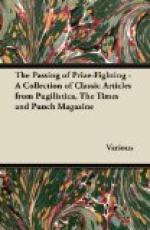The other day I did a perfectly dreadful thing: I intruded, all unconsciously but in the most blundering way, on a love scene. It was in the National Gallery, long famous as the meeting-place of affinities, in the big room where the pictures lent by the Duke of WESTMINSTER and the Duke of BUCCLEUCH are now hanging, and before I knew it I found myself standing between two young people whose eyes were fixed on each other. Naturally I moved away at once, but later I returned and made so bold as to study them a little, for it was clearly, if not yet a passion, a mutual interest of such tender depths that no outsider could affect it.
The boy—for he was no more—was one of the most beautiful that I have ever seen. His hair was perhaps a thought longer than we encourage to-day, but one always sees odd people in the National Gallery, where artists—most careless of men—are now constant visitors, drawn there by the many new pictures, and especially, perhaps, the modern French examples from Sir HUGH LANE’S collection. His hair was the more noticeable because he carried his hat in his hand; his clothes were noticeable too, being a shade too fanciful for London in winter—but then, who cares how people dress in London? I am sure I don’t; and especially so when they have such eyes as this boy’s, dark and rich, and such a curve to such lips.
There he stood, perfectly still, his steady gaze fixed on the lady opposite, while she in her turn never wavered in her gaze upon him. But whereas there was something bold in his homage there was a half-shy way with her. He was facing her squarely, but she looked at him a little sideways, and a little curiously, in demure dubiousness. One could see that she was enormously intrigued, but her interest was not expressed by any movement. In fact neither moved; they remained some twenty yards apart all the time I observed them: each, I suppose, leaving it to the other—the boy because he was so young, the girl because she was already woman, and woman likes to force advances from man.
I never saw a prettier thing than the little lady, with her cool white skin, and the faintest flush on her cheeks, and her eyes not less dark than the boy’s but lacking the sensitive depths of his.
The odd thing was that, although they were so engrossed each in the other, both, I observed, looked also at me. It struck me as not the least strange part of this charming drama that its hero and heroine, while completely absorbed in their own sympathetic relationship, should be able to turn a calm survey upon a stranger too. This gift made them the more memorable and perhaps explains why, for all the rest of the day and at intervals in the night and morning following, I thought of these young people, speculating as to how they were getting on; and perhaps that is why, the next afternoon, drawn by invisible wires, I found myself in the National Gallery again.
Will you believe it?—they also were there. This is an absolute fact. There they were, exactly as I had left them. And yet, not exactly, for I am certain that there was a hint more of seriousness in the lady’s glance and a shade more troubled earnestness in his. But as regards actual distance, they were still as far apart, although certainly nearer in spirit.




